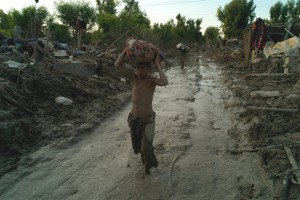August 4, 2011
A word from Ross Mountain
A year after Pakistan suffered one of the worst natural disasters that we can recall, followed by one of the largest appeals at over $2 billion in the history of the United Nations, the country faces a new monsoon spell. The rains, which could affect up to 5 million people, are inevitable. Damage and loss of human lives are not, but it is not just about well-intended and generous responses.
The question now is whether we have made use of the invested resources, lessons learned and experience gained from past disasters in order to reduce the vulnerability of Pakistan’s population to the annual cycle of torrential rains.
In 2011 our research, which included a Real-Time Evaluation of the floods, indicated that the humanitarian system’s response capacity had been stretched to the limit, not only due to the unprecedented magnitude of the disaster which affected some 20 million people and the limited humanitarian space, somewhat improved after the floods, but in particular due to the poor implementation of the lessons learned from previous crises.
Evaluations after mega-disasters – such the Tsunami in Southeast Asia , the earthquake in Haiti and last year’s floods in Pakistan – all point to the need to invest more resources and political will in disaster prevention, preparedness and risk reduction, as well as resilience-building of local actors. Failure to do so has meant millions of people have been unnecessarily affected by disasters, and threatens to intensify the impact of future ones.
Efficient coordination amongst all actors is also persistently missing in the response to crises worldwide, and Pakistan was no exception. A major bottleneck was the capacity of the humanitarian actors to respond to the huge needs. Coordination was not particularly efficient due to a continuous lack of qualified leadership, an excessive number of meetings, and cluster leads more preoccupied with own agency interests rather than the cluster members at large. High staff turnover led to discontinuity in coordination efforts.
And more importantly, especially in contexts such as Pakistan, donor governments need to step-up efforts to ensure needs-based responses based on impartial assessments, avoiding the delivery of aid to be caught up in a complex interplay between competing national and international political, military, security or development concerns.
Vulnerable populations deserve to be protected against the vaguarities of Mother Nature as well as receive the most effective relief and support when these measures do not suffice. But if the lessons painfully learned from past disasters are not applied, affected people are obliged to undergo needless suffering- no matter how well meaning and generous the response might be. Today’s crisis in the Horn of Africa is the yet another example where early warning was not heeded and previous lessons seem to have been ignored.
The challenge today for the Pakistani authorities and the international community is to take such action as is possible now and demonstrate what has been learned from recent experience to avoid the new monsoon rendering so many of the already vulnerable more vulnerable.
Progress has been made. Especially in scientists’ ability to predict disasters. But governments and the international community need to apply this knowledge to improving the way we prepare for them and mitigate their impact. When the rains next pour down in Pakistan, it is the responsibility of both parties to ensure that they do so on an increasingly better equipped and more resilient population. It is also their responsibility to be better prepared to respond to current and future challenges.

Share this